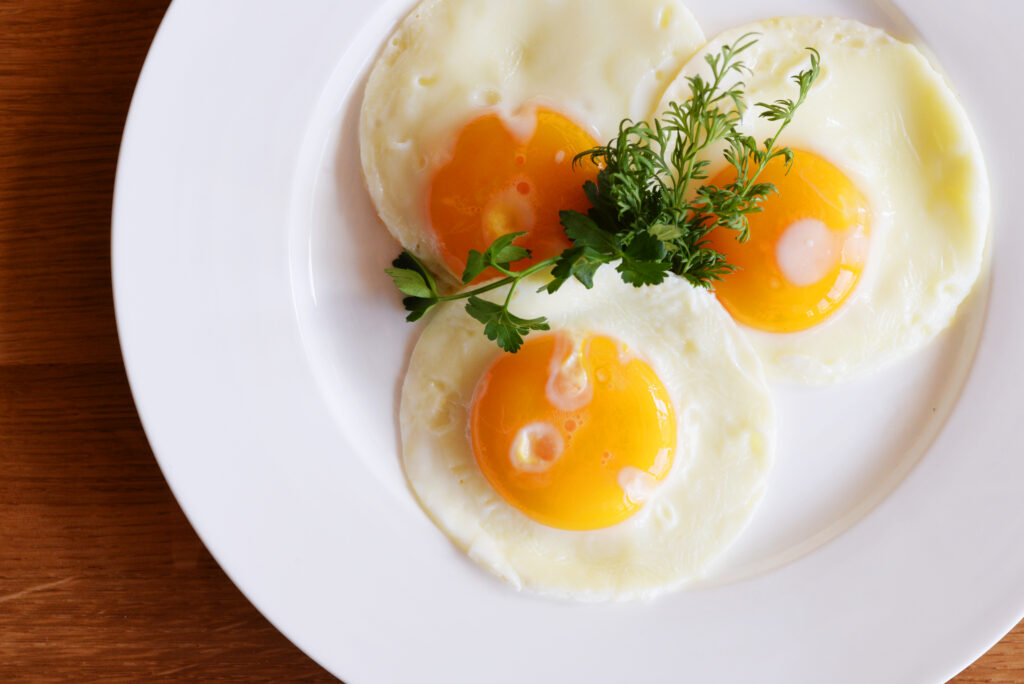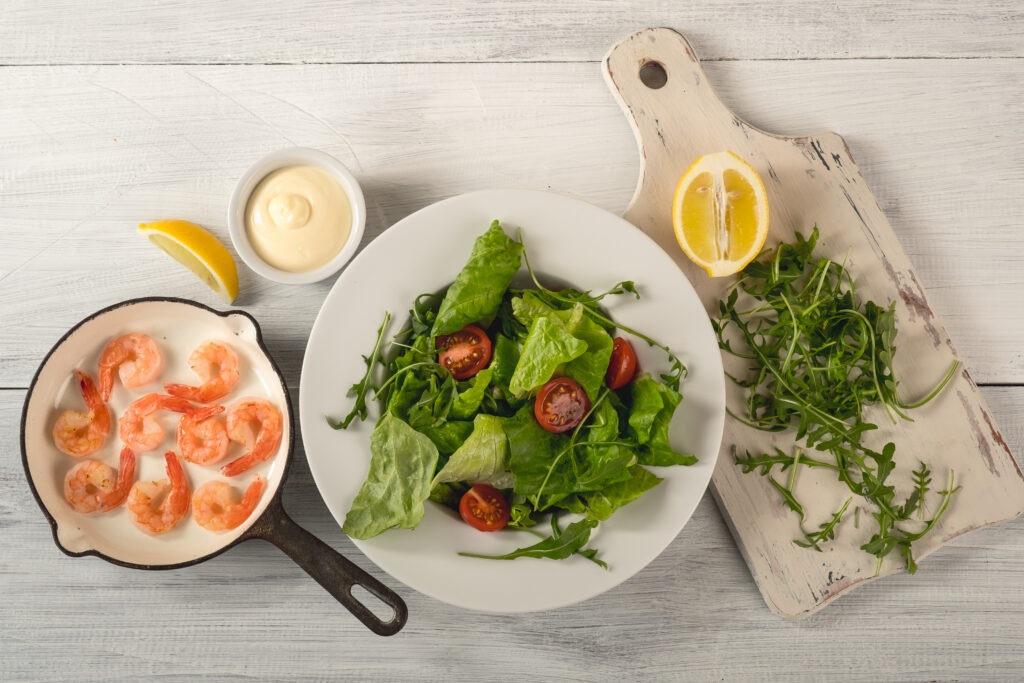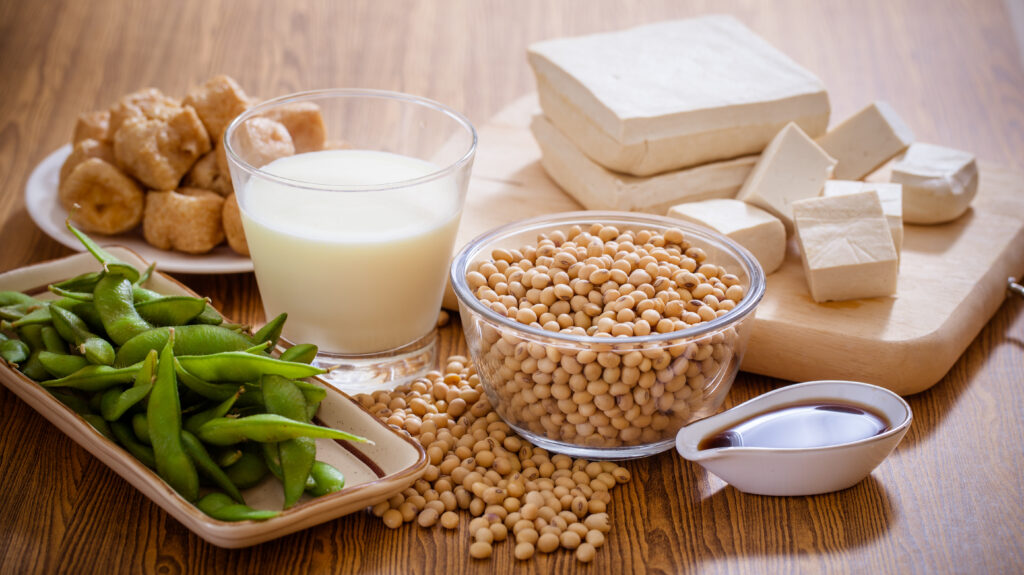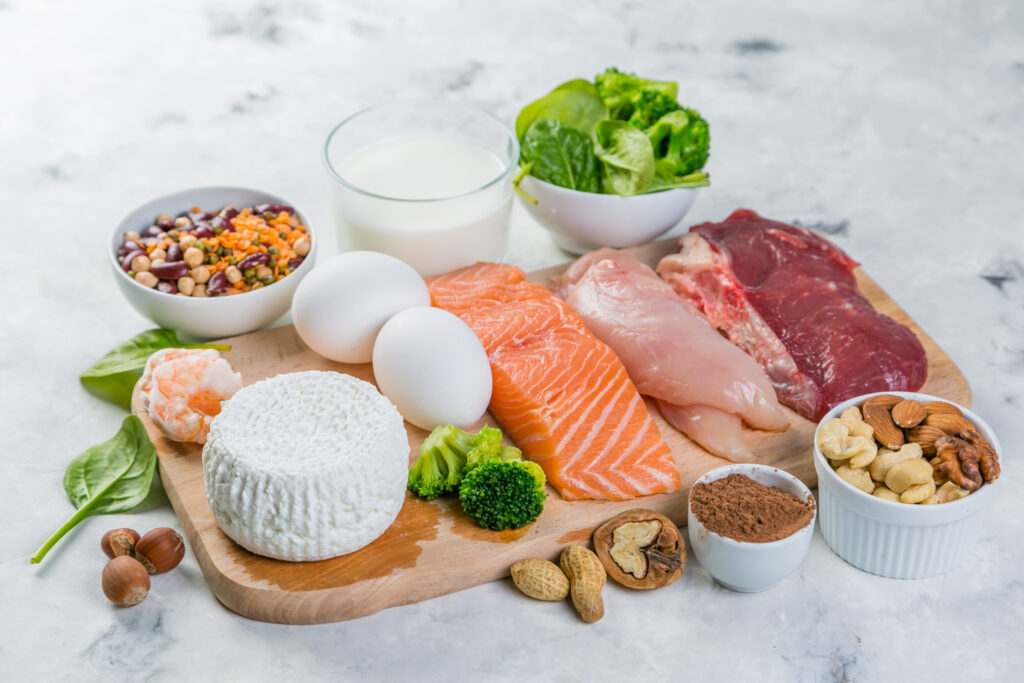Meet Your Macros: The Power of Protein
Protein: It’s a favorite of fitness fanatics and bodybuilders the world over, but what about the everyday athlete, the person just trying to live a healthy lifestyle by incorporating a few trips to the gym into their routine each week?
If you follow mainstream media’s reporting on nutrition, you may have been led to believe that of all the things to worry about in keeping a healthy diet, protein isn’t one of them. Experts from the medical community are continually quoted as saying that most Americans get “more than enough,” even “too much” protein in their diets without even trying.
But is this true? How much protein is “enough”? And is it really possible to have “too much”?
The first thing to know is that “enough” is all relative, and reports claiming that most Americans get “enough” are aimed at a largely sedentary population. But just as a more active lifestyle requires a higher-calorie diet, it also requires a higher protein diet.
In our last post on nutrition basics, we explained what defines “enough” in the eyes of the National Academy of Medicine: .36 grams of protein per pound of bodyweight per day. For a person weighing 150 pounds, that equates to 54 grams of protein per day. It’s important to note, however, that “enough” is simply the bare minimum: an inactive 150-pound person who gets at least 54 grams of protein in their diet each day will not suffer from a protein deficiency.
What they don’t tell you is that formula changes drastically for an active person, especially one looking to build or maintain muscle. For a person who is “moderately active,” defined as working out at least three days per week and being generally active during the day, the goal should be .9 grams per pound. For an “active” individual — like any CFN member who regularly makes it to the gym 4-5 days per week — that recommendation rises to 1 gram per pound. And for those who are “very active,” athletes training at least an hour per day or those working in physically demanding jobs, the recommendation is 1.1 to 1.2 grams per pound.
So let’s go back to our 150-pound person: Depending on their exercise habits, their actual protein needs will in fact range from 135 to as many as 180 grams of protein per day — more than three times as much as they might be led to believe they need to be healthy.
MythBusters: Protein Edition
With these numbers in mind, is it really possible to have “too much” protein? Theoretically, sure. Like carbs and fat, protein has calories — 4 per gram — and consuming more calories than you burn will cause you to gain weight. Some animal-based sources of protein, like red meat, can also be high in unhealthy fats, and some plant-based protein sources, like beans, are also high in carbohydrates, so trying to meet your protein intake goals on bacon cheeseburgers or huge quantities of beans is going to result in consuming a lot of additional calories from fat or carbs. And, of course, eating protein at the expense of other essential components of a balanced, healthy diet — like fiber-rich vegetables, high quality carbohydrates, and healthy fats — can lead to a different set of deficiencies.
But if you’re choosing high quality proteins — a chicken breast, for example, is almost entirely protein — it’s much more likely that you’ll struggle to get enough than run the risk of having too much. Our 150-pound person would need to eat around 1 whole pound of chicken breast to hit 150 grams of protein on chicken alone.
Other internet fearmongers will lead you to believe that having too much protein is going to cause kidney problems as they are overloaded with waste products that build up in your bloodstream from the processing of protein within your body. While this may be an issue for people already suffering from or predisposed to kidney problems — and many Americans, knowingly or not, may fall into this category due to being overweight or prediabetic — research has shown that higher protein intake is unlikely to be risky for healthy individuals.
It has also been theorized that high protein intake may have a negative effect on bone mineral content, a particular concern for aging populations at risk of developing arthritis or osteoporosis. Current research, however, has shown an opposite effect: assuming adequate intake of calcium and sufficient vitamin D, higher protein intake is in fact beneficial for good bone health.
Protein might not hurt me … but will it help me?
Yes.
Whether your goal is to add a few pounds to your squat, finally get a pull-up, become the next Arnold Schwarzenegger, or just be generally healthy and maybe lose a few pounds, protein is your friend.
Protein is responsible for most of your body’s structural integrity. That includes muscles, of course, but also your hair, skin, and nails, and the growth and repair of other body tissues. A diet deficient in protein will lead to weakness and fatigue, brittle hair and nails, and frequent illness since your immune system is not getting all of the support it needs.
Protein intake is especially important if your goal is to lose weight. When you’re trying to shed a few pounds, you want those pounds to be excess body fat — not muscle mass. Create your calorie deficit by reducing your intake of fats and carbohydrates, but make sure you’re still eating enough protein to support or even grow your existing muscle mass.
In addition to helping build and maintain muscles, higher protein intake can help you burn more calories throughout the day. All foods require some energy to digest, meaning that your body burns off some calories through the digestion process. This is known as the thermic effect of food, and it’s significantly higher for proteins — around 20 to 30 percent of the amount ingested — than it is for carbs (5 to 10 percent) or fat (0 to 3 percent).
And protein keeps you full — more on that below — meaning that a higher protein diet can lead you to consume fewer calories overall without any intentional restriction. You’ll simply be less hungry.

When should I eat my protein?
Ideally, you’re spacing your daily consumption of protein across all of your meals and snacks. This helps to ensure that you’re getting enough protein and helps you avoid excessive snacking or over-indulging on sugary foods since protein-rich foods tend to be the most satiating. You can thank your hormones for this effect: protein reduces concentrations of ghrelin, the “hunger hormone,” and stimulates the production of peptide YY, a hormone that targets satiety centers in your brain and makes you feel full.
Another argument in favor of spacing out protein consumption throughout the day has been the long-standing consensus that, depending on body weight, your body can only “use” a maximum of 20 to 35 grams of protein from a given meal, and that therefore protein consumed in excess of this amount in a single meal is simply extra calories. However, new research has called this conventional wisdom into question — and shown benefits to higher protein meals — for both young and older adults.
What is a “good” protein?
What constitutes a “good” protein is not just a matter of opinion and personal preference: there’s some science to it all. But, like most things in the realms of diet and nutrition, the best proteins will be the ones you enjoy enough to ensure that consuming enough protein every day doesn’t become an unpleasant chore. Chicken breast is a fantastic protein option, but if you can’t stand the taste, don’t try to make it the centerpiece of your protein-forward diet. There are plenty of other options.
All proteins are composed of amino acids, of which nine are considered “essential” in that they must come from the diet. A complete protein is one that contains all nine of these amino acids. Animal proteins — meat, poultry, fish, eggs, and dairy — are all complete proteins. Plant-based complete protein options are more limited and include soybeans, hempseed, quinoa, and buckwheat.
Of course, not all of your protein sources need to be complete proteins, and, particularly if you follow a plant-based diet, combining multiple protein sources will get you to the same place: nuts, seeds, or beans with whole grain bread (for example peanut butter on toast or pita bread and hummus).

Sources of protein also vary in the proportion of their component essential amino acids that are absorbed in the small intestine during digestion. This is reflected in a number known as the DIAAS, or Digestible Indispensable Amino Acid Score. Proteins that score at the top end of this metric include whole milk, hard boiled eggs, chicken, and beef, while items like peas, wheat, and rice score toward the bottom of the chart. It’s not surprising that plant-based foods are toward the bottom of the list — most plant-based foods are not complete proteins — but it also doesn’t mean that you can’t get all of the protein you need following a vegetarian or vegan diet. You simply need to combine various plant-based protein sources in order to ensure you’re covering all the essentials (you can read some research on this here).
Stock up
What does this all mean for your weekly grocery haul? Here’s a shopping list with some good options in the realms of animal and plant-based proteins.
Animal proteins
Lean meats: This includes chicken and turkey as well as lean cuts of beef like sirloin, ideally grass-fed. The white meat portions of chicken or turkey have proportionally more protein and less fat than the dark meat portions, but many people prefer the flavor of the dark meat, and both have plenty of protein: chicken breast offers about 30 grams of protein per 100 grams of meat, while chicken thighs have about 25 grams of protein per 100 grams. (It’s eating the skin from either of these birds that’s going to make the fat calories start to add up.)
Red meat from beef gets a bad reputation because of its high saturated fat content, but leaner cuts offer a lot of nutritional benefits in addition to their high protein content. Sirloin, for example, has 27 grams of protein in a 100-gram serving and is an excellent source of zinc, iron, B vitamins, and omega-3 fatty acids. And if you’re feeling adventurous, bison meat is also a leaner red meat alternative to beef from a cow.
Try to limit consumption of fattier cuts of beef and heavily processed meats like hot dogs, bacon, and sausage. They are lower in protein and higher in saturated fats, sodium, and preservatives.

Eggs: A whole egg has about 70 calories, with about 6 grams of protein and 5 grams of fat. The white of the egg is almost entirely water and protein, while all of the fat, more protein, and many additional nutrients are packed into the yolk. To help limit fat consumption, use a combination of whole eggs and egg whites from a carton, but don’t skip the yolks entirely: they’re packed with vitamins A, B12, B2, B5, and D, and choline, a nutrient essential to brain function.
Fish: Many types of fish are almost entirely protein and have the added benefits of supplying big doses of vitamins D and B12. Cod, tilapia, and halibut are good examples of fish in this category.
Water-packed canned tuna is also a great option, and while it shouldn’t be an everyday protein choice due to concerns about mercury content, adding it to your diet a few times per month is perfectly safe, and there is plenty of research out there on which brands are the best choices.
Wild-caught salmon is a good source of protein but also a significant source of fat. These are healthy fats — particularly those all-important omega-3s — but it is a higher-calorie option compared to some of the leaner fish.

Greek yogurt or skyr (Icelandic yogurt): These strained yogurt products are high-protein and are also a great source of probiotics, good bacteria that help keep your gut healthy. While these are dairy products, the process of making them removes most of the lactose, meaning that even those who don’t typically tolerate cow’s milk or other dairy products well may be fine with small amounts of these yogurts.
Avoid yogurts with fruit already added in, as these are usually also packed with added sugar. Instead, start with plain yogurt and add your own berries or other toppings. These yogurts also come in full fat or no fat options, and both are good choices depending on your calorie needs and what you’re eating with it. While diet culture has long preached that low fat is the way to go, more recent research is showing that consuming full-fat dairy can actually help in achieving weight loss goals without increasing the risk of heart disease.
Plant proteins
Many plant-based protein sources are also high in fats (for example, nuts and seeds) or carbohydrates (beans, peas).
Soy products. These include such foods as tofu, tempeh, and edamame. Soy is a complete protein, which makes it a great staple of plant-based diets. While soy products do have moderate amounts of fat, they are also a good source of fiber and essential minerals like iron, magnesium, and zinc. In a half-cup serving, firm tofu has about 10 grams of protein, edamame has 8.5 grams of protein, and tempeh has 15 grams of protein.
Seitan. Skip this one if you have issues with gluten, since it’s made entirely of wheat. If gluten works for you, though, 2 ounces of seitan is only 100 calories with 17 grams of protein.
Quinoa. While it’s consumed like a grain, quinoa is technically a seed and is also a complete protein. It’s gluten-free and has fewer carbohydrates and more micronutrients than white rice, and one cup of cooked quinoa will get you 8 grams of protein along with 5 grams of fiber.

Beans & Other Legumes. Lentils, black beans, kidney beans, fava beans, pinto beans, chickpeas, etc. — all of them are going to get you around 7 to 9 grams of protein in a half-cup serving along with fiber and other micronutrients. Green peas, also a legume, have 8 grams per cup along with fiber, some iron, and all the vitamin C you need, which helps with iron absorption. Keep in mind, however, that carbohydrates account for about 75 percent of the calories in these foods.
Nuts. While nuts are primarily a source of healthy fats — and thus serving sizes are relatively small, with an ounce, or around 30 grams, clocking in between 150 to 200 calories — that serving also brings in 5 to 7 grams of protein, depending on the nut. It’s actually peanuts (technically a legume) that have the most protein per gram, with almonds, walnuts, and pistachios also high up on the “healthy” list. Of course, nut butters will also help you reach your protein goals, but look for “natural” versions that are just nuts and salt, with no added sugar.
Seeds. These are similar to nuts: they tend to derive most of their calories from fat, but can also add a decent amount of protein and fiber. Chia, flax, and hemp seeds are all good choices — hemp seeds in particular are a complete protein. Raw pumpkin seeds will also net you 8 grams of protein per 30 gram serving and are also a great source of iron, a mineral abundant in red meat that can be harder to get enough of on a plant-based diet.
Veggies. And finally, a little love for vegetables. Yes, they’re mostly water, carbs, and fiber, but some also have non-trivial amounts of protein. They shouldn’t be your go-to choice for boosting your protein intake, but including 3-5 servings of veggies per day will help you inch toward your protein intake goals while also providing a whole host of important micronutrients. Vegetables with relatively high protein content include broccoli, spinach, kale, brussels sprouts, and artichokes.
What about protein powder?
If you can meet your protein needs by eating real foods, that’s ideal, but there’s no denying the convenience of getting a meal’s worth of protein out of a scoop of cookie-flavored powder added to your water bottle. Use protein powder if you have a hard time getting enough protein through diet alone or if you need something that is quick and easy when your schedule doesn’t allow you time for a real meal.
This is especially true if you’re not able to have a meal or substantial snack with an hour or two of your workout: ideally you want to eat something with a 3-4 to 1 ratio of carbs to protein within that window in order to begin replenishing glycogen stores (i.e., sugar stored in your body for energy) and start the process of muscle repair. A shake with protein and carbs is one easy way to accomplish this. In most cases, this is a better choice than a protein bar, which tends to have a lot of added sugar, fat, and other less nutritious ingredients.
Protein powders come in many different varieties (and flavors), and not all protein powders were created equal. While the source of protein may vary — whey (dairy) protein is the most common, but other options like soy, hemp, and pea protein are out there for those who may be vegan or highly lactose intolerant — try to seek out protein powders with minimal extra ingredients, typically added for sweetness and to improve blendability. Whey protein digests quickly and has high bioavailability — that is, your body can absorb and use a large proportion of it — so it works well to fulfill pre- and post-workout protein needs.
A note for protein shoppers: whey protein powders are labeled as either “whey protein concentrate” or “whey protein isolate.” Whey isolate is more processed than whey concentrate and has more protein and fewer carbs and fat than whey concentrate. This means that lactose content is lower in whey isolate, so it’s a good option for those who are sensitive to dairy products. The additional processing also means that whey isolate tends to be more expensive, and if your only concern is the efficacy of the protein itself, the two products are going to give you essentially the same benefits.

Piecing It All Together
The bottom line is this: adequate protein intake is one of the most important pillars of a healthy diet, especially for athletes, and a good starting point is to aim for around 1 gram of protein per pound of bodyweight per day. Don’t make this a chore! Experiment with different high-quality protein sources, and pick the ones you genuinely enjoy eating. And let us know: what are your favorite protein-packed recipes?
Next in the meet your macros series: all about carbs.


Leave a Reply